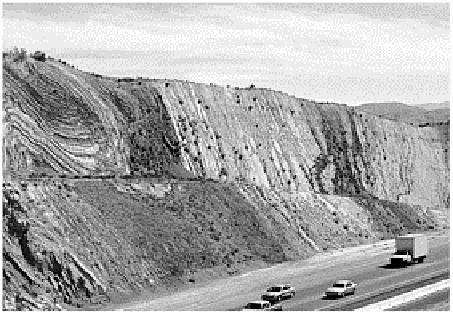Environmental Engineering Reference
In-Depth Information
reaction surfaces on either side of the fault where it crosses
the eastern San Gabriel mountains.
Photos: Ken Addison.
(c) The mobile nature of the fault zone is reflected by vertical
and disharmonically folded strata, particularly in deformable
desert gypsum, in this highway cutting near Palmdale,
western Mojave desert.
Photo: Ken Addison.
4 km in mean elevation over 0·4 million km
2
, and the Colorado Plateau (0·5 million km
2
and 1·9 km high) have similar origins. Uplift of the latter triggered 2 km of spectacular
incision of the Grand Canyon by the Colorado river, exposing 1 Ma of earth history.
Plateaux not underlain by thick crustal lithosphere are elevated by epeirogenesis.
Occasionally one plate continues its advance into another. The Indian continental
subplate has achieved this,
indenting
(penetrating) the Eurasian plate by a further 2,000
km since initial collision
c
. 40 Ma ago and continuing to promote
indentation tectonics
well into Asia.
CONTINENTAL FORMATION, EVOLUTION AND ARCHITECTURE
We have seen that tectonic activity exchanges material between ocean and continental
crust, consigning some terrestrial erosion products to the subduction melting pot and
accreting ocean sediments and crust (as ophiolite) on to continental margins. Yet their
mean ages indicate that continental crust (1·1 Ba) is largely conserved, whereas oceanic
crust (55 Ma) is largely recycled. It is thought now that new continental crust has been
added slowly, by the accretion of oceanic plate at a rate of approximately 1·3 km
3
yr
−1
over the past 1 Ba. Some 50-70 per cent of primary continental crust was formed by
c
.
2·5 Ba ago, during the Archaean. Continental lithosphere - a 'penultimate silicate froth'
containing, additionally, some of Earth's least common elements - is the descendant of

